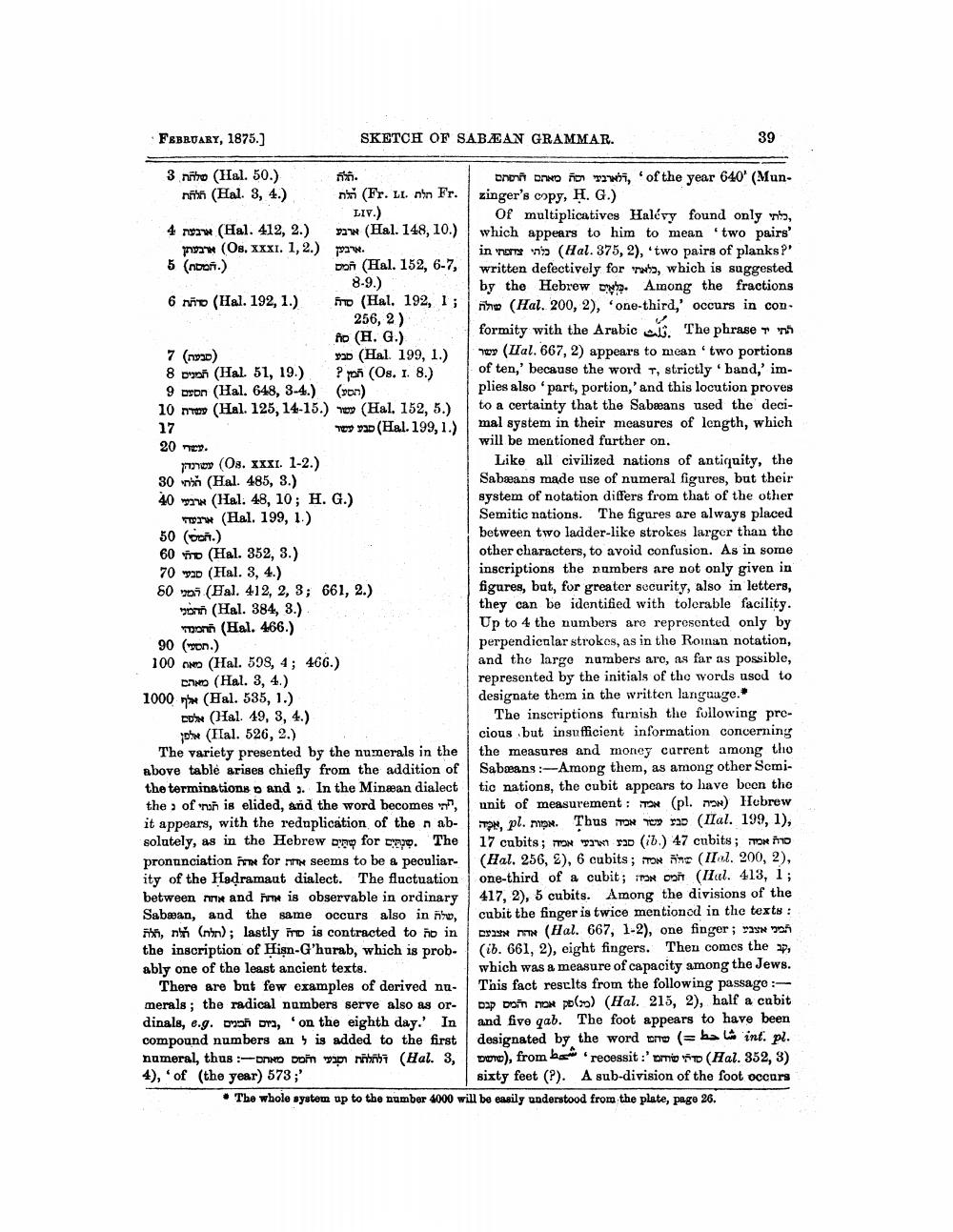________________
FEBRUARY, 1875.]
3 nito (Hal. 50.)
ni (Hal. 3, 4.)
4 raw (Hal. 412, 2.)
5 (noon.)
6 no (Hal. 192, 1.)
7 (930)
8 h (Hal. 51, 19.) 9 Don (Hal. 648, 3-4.) 10 T (Hal. 125, 14-15.)
17
ארבען .12 .Os, XXXI) ארבעתן
עשר 20
(08. XXXI. 1-2.)
חלה
wrw (Hal. 199, 1.)
n (Fr. LL. nin Fr. LIV.)
21 (Hal. 148, 10.)
SKETCH OF SABEAN GRAMMAR.
30 min (Hal. 485, 3.)
40 ww (Hal. 48, 10; H. G.)
Don (Hal. 152, 6-7, 8-9.)
FO (Hal. 192, 1;
256, 2) ño (H. G.)
ya (Hal. 199, 1.) ?ran (Os. 1. 8.) (ron)
DON (Hal. 49, 3, 4.) phe (Hal. 526, 2.)
(Hal. 152, 5.) TYD (Hal. 199, 1.)
50 (on.)
60 (Hal. 352, 3.)
70D (Hal. 3, 4.)
60 (Hal. 412, 2, 3; 661, 2.) (Hal. 384, 3.)
Tonn (Hal. 466.)
90 (on.)
100 AND (Hal. 598, 4; 466.) CANO (Hal. 3, 4.)
1000 (Hal. 535, 1.)
The variety presented by the numerals in the above table arises chiefly from the addition of the terminations and . In the Minean dialect the of non is elided, and the word becomes", it appears, with the reduplication of the n absolutely, as in the Hebrew on for app. The pronunciation Fre for seems to be a peculiar ity of the Hadramaut dialect. The fluctuation between me and Fire is observable in ordinary Sabaan, and the same
, n (nn); lastly is contracted to no in the inscription of Hisn-G'hurab, which is probably one of the least ancient texts.
The inscriptions furnish the following precious but insufficient information concerning the measures and money current among tho Sabaans:-Among them, as among other Semitic nations, the cubit appears to have been the unit of measurement: T (pl. ) Hebrew O, pl. mp. Thus ONTD (IIal. 199, 1), 17 cubits; ON A TAD (ib.) 47 cubits; OR D (Hal. 256, 2), 6 cubits; mos ne (IIl. 200, 2), one-third of a cubit; TON on (Hal. 413, 1; 417, 2), 5 cubits. Among the divisions of the cubit the finger is twice mentioned in the texts: DINN (Hal. 667, 1-2), one finger; (ib. 661, 2), eight fingers. Then comes the 7, which was a measure of capacity among the Jews. This fact results from the following passage:Day Don now po(2) (Hal. 215, 2), half a cubit and five qab. The foot appears to have been designated by the word te (ha int. pl. DW), from recessit:'D (Hal. 352, 3) sixty feet (?). A sub-division of the foot occurs • The whole system up to the number 4000 will be easily understood from the plate, page 26.
39
Oй DO ñ wii, of the year 640' (Munzinger's copy, H. G.)
Of multiplicatives Halévy found only ri, which appears to him to mean 'two pairs' in res (Hal. 375, 2), 'two pairs of planks?' written defectively for r, which is suggested by the Hebrew. Among the fractions (Hal. 200, 2), 'one-third,' occurs in conformity with the Arabic. The phrase n www (Hal. 667, 2) appears to mean 'two portions of ten,' because the word T, strictly band,' implies also part, portion,' and this locution proves to a certainty that the Sabeans used the decimal system in their measures of length, which
C
will be mentioned further on.
There are but few examples of derived numerals; the radical numbers serve also as ordinals, e.g. Da ora, 'on the eighth day.' In compound numbers an is added to the first numeral, thus :-DANO Dom w (Hal. 3,
4), of (the year) 573;'
Like all civilized nations of antiquity, the Sabæans made use of numeral figures, but their system of notation differs from that of the other Semitic nations. The figures are always placed between two ladder-like strokes larger than the other characters, to avoid confusion. As in some inscriptions the numbers are not only given in figures, but, for greater security, also in letters, they can be identified with tolerable facility. Up to 4 the numbers are represented only by perpendicular strokes, as in the Roman notation, and the large numbers are, as far as possible, represented by the initials of the words used to designate them in the written language.
,שלח occurs also in




